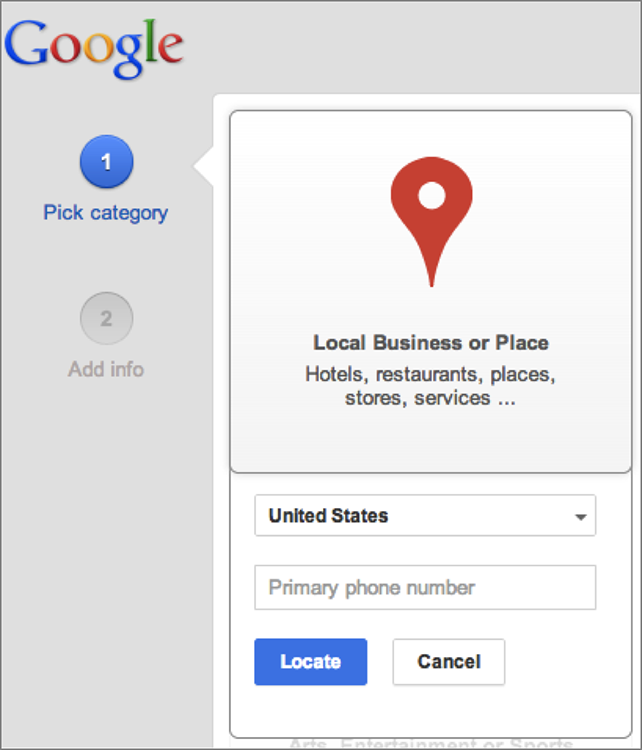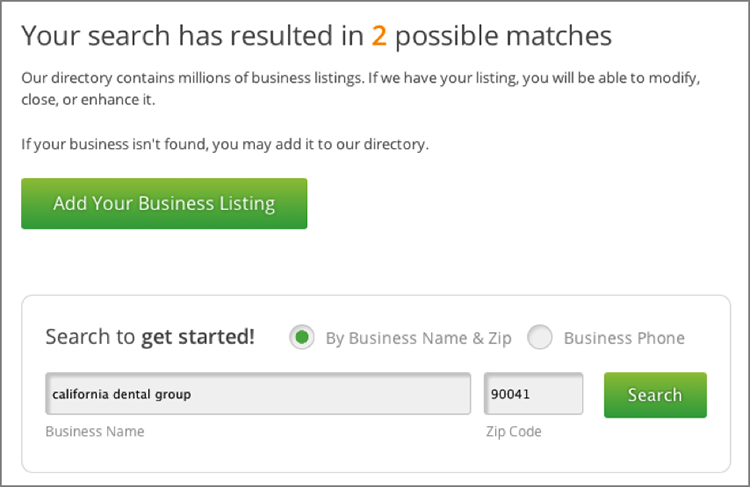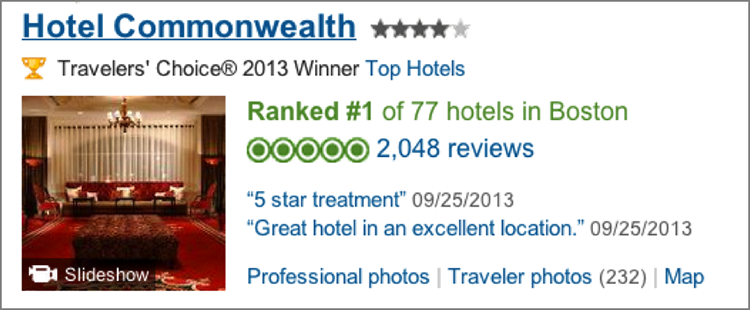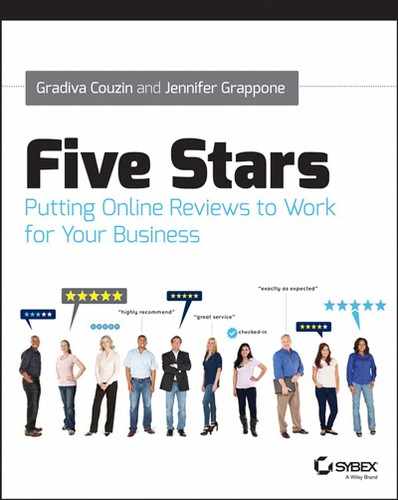Chapter 9
Maintaining Your Momentum
It’s time to take the valuable knowledge you’ve gained about your reviewscape and translate it into action. In this chapter, you’ll set your course for a sustainable ongoing effort of managing and leveraging your business’s online reviews. Don’t get distracted by thoughts about the amount of work ahead or the size of the gap you’re trying to close; just take it one step at a time. The key to a successful review management plan, like any successful business improvement effort, is to set practical goals and build on them as you move forward.
In this chapter:
- Developing your plan
- Power moves for a time-strapped small business
- Reaching for the stars
Developing Your Plan
Dealing with your online reviews is a fluid process, one that requires agility and reactivity on your part. But that doesn’t mean you can’t have a plan going into it. As consultants, we’ve learned that it’s often a good idea to plan ahead with a linear framework, even if you know that you’ll need to change course at times to follow a shifting landscape. Here, we’ll help you march forward with a roadmap in hand that best meets your business’s needs and capabilities.
This book covers a lot of ground and a wide range of recommended activities. Let’s break it down. Here are the basic elements of a review management program:
- Completing and optimizing the business’s profiles
- Monitoring reviews
- Learning from reviews and making changes for the better
- Seeking reviews
- Responding to reviews
- Advertising
- Measuring results
With the exception of advertising, each of these elements is a must-have component of your ongoing online reviews project. Some can be skimped on; others can’t. Some of them can be aided along the way with paid tools, but most will require a degree of labor on your part. How this plays out pragmatically for your business depends on the resources you have available and the priority you place on online reviews, online reputation, and online acquisition as a whole.
In the following sections, you’ll find a sample set of activities that covers the key components we think any review management plan should include. Every business is different, so this plan may fit you like a glove or need a little tailoring. Read for insights, then adapt to your reality.
Local Businesses: Find and Update Your Presence on Review Venues
Basic profile housekeeping is a great first step for businesses that are reviewed on third-party sites, including local businesses, service providers, hotels and destinations, nonprofits, and professionals. Create or claim your business profiles and clean up and optimize the elements that you have control over to ensure that your business is represented accurately and all the pieces are in place for you to accumulate reviews.
The following steps should be performed as kick-start activities and revisited on a regular basis when your time allows:
- Identify the review venues that are most important to your business. See the sidebar “Exercise: Know Which Review Venues Deserve Your Attention” in Chapter 4, “Monitoring and Learning from Your Reviews.”
- Claim or create and optimize your business’s review site profiles, starting with your top-priority venues. If the venues you want to approach are Yelp, Google+ Local, TripAdvisor, Angie’s List, or ResellerRatings, you’ve got detailed instructions in Chapter 6, “Review Venues: Need-to-Know Tips for Your Action Plan.” The following graphic shows the first step in creating a new local listing on Google. Most likely, there will be some sites on your list for which this book has not provided detailed instructions. If that’s the case, you’ll need to improvise, following the patterns and philosophy described in Chapter 6.

- Eliminate any duplicate listings you find, correct inaccuracies, and fill out your listings completely. Don’t skimp on compelling details about your business, and be sure to add up-to-date photos. Optimize your text with keywords to the best of your ability. See the sidebar “Optimize Your Listings with Keywords” in Chapter 6.
- Claim your business listings in feeder directories such as Acxiom, Express Update, and Localeze; these can feed into review sites and provide citations that may improve your search engine visibility. The following graphic shows an example. Update, de-duplicate, and edit your business directory listings to ensure that they are accurate and consistent. See the sidebar “Online Reviews and Google’s Local Search Rankings” in Chapter 8, “Showing Off and Being Found.”

- Documentation is crucial: As part of your commitment to being found and represented accurately online, be sure to document logins for all venues on which your business has a listing.
If you have a marketing department, they are likely to be the right team to take charge of the above tasks. In a smaller business, this work can be handled by the owner. If you hire an outside vendor to complete this work, be sure that your business is in control of the logins; you do not want to lose access when a paid relationship ends.
E-commerce Sites and Brands: Make the Most of Product Reviews
E-commerce businesses, manufacturers, and brands should take maximum advantage of the benefits of product reviews. Here are some important activities for you to include in your plan:
- If you sell products on your site but you don’t have the capability to gather and display customer reviews, get the technology in place to make that happen, either with your e-commerce platform or a social commerce tool such as Bazaarvoice or Reevoo. See “Social Commerce/Product Review Platforms” in Chapter 2, “The Online Reviews Landscape,” and “Product Reviews and SEO” in Chapter 8 for products and capabilities to think about.
- Identify ways to increase the prominence or effectiveness of reviews on product pages and throughout your site, as described in the section “Visibility on E-commerce Sites” in Chapter 8. If you’re able to customize review features and functionality, such as displaying reviewer names, photos, and reviewing history, read the section “Influencing Factors in Reviews” in Chapter 3, “Understanding Reviewers and Reviews,” so that you can be sure to include all the information your potential customers want to see.
- Get stars in your organic search engine listings if you can. Learn how these enhancements are achieved in the section “Rich Snippets” in Chapter 8.
Your product review effort is likely to require an up-front investment of time and money in setting up and configuring a review tool, but the real return comes over time. With product reviews on your site, you have a chance to reap the rewards of a documented sales lift, and you’ll be able to continually improve your products or services based on the feedback you receive.
All Businesses: Monitor Your Reviews
Sure, you’ve had an eye on your reviews all along, but the goal here is to arrive at a sustainable, repeatable monitoring process that allows you to gather information wisely and not get bogged down in details or the occasional slam. This task does not need to fall on the business owner. A brand manager, marketing director, or any smart staffer can take on regular monitoring duty—and there are tools to help. Here are some recommended activities for monitoring reviews of your business:
- Commit to having a business representative read your reviews on a regular basis—the frequency depends on the volume of reviews you receive. See Table 4-1, “Review Monitoring Tools,” in Chapter 4 for tools that can make this easier for you. If you have more reviews or social media mentions than you can realistically absorb, focus on a sample of recent reviews, or just on your most popular products or top venues for now. If you need inspiration, here’s an example of a happy ending that never could have happened without monitoring:

- Configure and use alert tools from review venues that you’ve identified as important to your business. See the “Review Monitoring Tools” section in Chapter 4, and learn details about dashboard capabilities for Yelp, Angie’s List, and TripAdvisor in Chapter 6.
- Determine a process for communicating takeaways, review sentiment summaries, and red-flag alerts to the people who can address the customer’s problem or craft a response. See the sidebar “Creating a Boss-Friendly Weekly Reviews Digest” in Chapter 4 for inspiration, as well as the sidebar “Crisis Management” in Chapter 7, “Navigating Negative Reviews,”for perspective.
Monitoring your online reviews is a task that will never end. Plan to periodically adjust the venues that you’re watching to be sure you’re keeping an eye on the ones with the best chance of landing in front of a prospective customer.
All Businesses: Use Feedback to Improve
In our opinion, businesses that think of reviews as first and foremost an opportunity to learn are the most likely to achieve success in the online review space. You don’t want to just fix bad reviews—you want to fix the problems that cause them. We know there are plenty of yo-yos out there with an axe to grind, but there are also many reviewers who are communicating something that your business needs to hear. Here are some ways to use review feedback effectively:
- Absorbing your reviews and using them to change for the better is likely to be a meandering process, but we encourage you to make it routine by folding it into an activity that’s already on your calendar, such as staff meetings, performance reviews, or product development brainstorming. Communicate actionable takeaways to your team, and ask them to share insights they have gleaned from direct customer interaction. Deliver compliments to the folks who have earned them and education and guidance to those who need it to improve. Hand off your customers’ great suggestions to those who can run with them.
- Document the sentiment in your reviews to help you transform raw feedback into workable directives following the approach described in the section “Learn from Your Reviews” in Chapter 4.
- Prioritize and take action on correcting issues, for example, by attacking easy fixes first, then moving on to better manage customer expectations and to address more pervasive issues that require a shift in your company’s culture or a step outside your comfort zone. See the section “Create a Process for Learning from Negative Feedback” in Chapter 7 and the sidebar “Brands Learn from Big Data with Bazaarvoice” in Chapter 4 for a few real-world examples.
- There are many ways to check in with customers aside from online reviews; meet with your staff to brainstorm ways to introduce more opportunities for customers to provide feedback. See the section “Check In With Customers” in Chapter 7, for some nonreview communication channels that you can use. This activity serves double duty by giving you just-in-time information you need to keep your customers happy and by discouraging negative reviews.
Making changes to your business based on online reviews may require an attitude adjustment; however, take this on and we think you’ll reap generous rewards in the form of happier customers and better reviews.
All Businesses: Respond to Reviews
No business should leave negative reviews hanging in the wind, and responding to reviews does not require a huge amount of time, though it does require a generous supply of humility. Here are some review response activities to consider for your business:
- There are lots of reasons to respond to reviews, but here’s one simple rule of thumb: If it’s visible, credible, and negative, it deserves a response. Set aside some time each week to carefully compose your responses to negative reviews. For guidance, see the section “Responding to Negative Reviews” in Chapter 7 and the sidebar “Exercise: Rate Responses to Negative Reviews,” also in Chapter 7, for real-world examples.
- Beyond negative reviews, try to determine which positive or neutral reviews you should respond to by putting yourself in your prospective customers’ shoes and deciding whether acknowledgment, thanks, correction, or reassurance would convey that you are a trustworthy and appealing business. See Chapter 6 for logistics and guidelines for communicating with customers in Yelp, Google+ Local, TripAdvisor, Angie’s List, and ResellerRatings. The sidebar “Hotel Commonwealth: Online Review Management Done Right,” later in this chapter, provides some review response ideas worth emulating.
- As part of your commitment to improving your online appeal to prospective customers, formalize your process for responding to future reviews (positive and negative). Determine which staffer or staffers will publish responses, and whether an approval cycle or internal review is required before posting. Develop templates, written policies, or style guides to streamline your future responses.
All Businesses: Encourage New Reviews and Leverage the Ones You Have
After the desire to seek-and-destroy bad reviews, the next line item on many businesses’ wish lists is to accumulate a healthy pile of positive reviews. Here are some activities we recommend:
- Formalize a review request process with a combination of outreach techniques such as post-transaction emails, incorporating links on your website, reminders in your brick-and-mortar business, or requests in your customer communications. See Chapter 5, “How to Get More Reviews,” for effective ways to cultivate reviews, as well as Chapter 6 for specific opportunities to gather more reviews on several major venues.
- Take opportunities to direct your customers to your review profiles. See the section “Badges and Widgets” in Chapter 8 for ideas on linking to review venues from your site.
- If Yelp is a priority for your business, remember that Yelp has a policy against requesting reviews from customers. Pursue alternative approaches such as asking customers for check-ins. See the sidebar “Don’t Ask, Don’t Yelp” in Chapter 5 and the Yelp section in Chapter 6 for details.
- If you have the budget for it, consider advertising opportunities on review sites. See Chapter 6 for ad options on Yelp, Google+ Local, TripAdvisor, and Angie’s List.
- Google your branded keywords—your company name, principals’ names, or products—to identify reputation concerns or problems with search engine ranks. Take steps to boost your brand and polish your online reputation in search engine results as described in the section “Improve Your Search Results” in Chapter 8. If you’re ready for a deeper dive into SEO, follow up with the sidebar “Opportunities for Further Learning,” later in this chapter.
- If you’ve got a good-looking collection of reviews, do what you can to place them in front of as many prospective customers as possible—for example, by featuring reviews on your website or in printouts at your brick-and-mortar location. See Chapter 8 for ideas on maximizing the benefit of your positive reviews, and see Chapter 6 for suggestions to increase your visibility on Yelp, Google+, TripAdvisor, and Angie’s List.
- You know all about the pitfalls of writing fake reviews or paying for positive ones, but does your team? Now might be a good time to create and distribute some guidelines to your in-house staff and outsourced team about staying within strict ethical boundaries when pursuing new reviews. Read the section “Authenticity and Ethics” in Chapter 5, the section “Fake Reviews” in Chapter 2, the sidebar “Yelp’s Controversial Filter,” in Chapter 5, and the sections focusing on review filters for several venues in Chapter 6.
Your review cultivation effort is likely to require persistence and flexibility. Document what works, and leave behind ineffective methods.
Power Moves for a Time-Strapped Small Business
Small business owners, we know how hard it is for you: If there’s one thing in scarcer supply than your cash, it’s your time. As one small business owner told us, “When it comes to marketing, I feel like I have to do everything! It’s exhausting. I need to know what’s really necessary.” We have a special place in our hearts for very small businesses, so we’ve put together some hit-the-ground-running steps for organizations with bare-bones resources.
Start with a couple of quick setup activities:
- Claim your profiles and fill them out as completely as you can. This will be the smartest 30 minutes you spend this week.
- Set up Google Alerts. A few simple Google alerts will keep you well informed about any new dings or points of light in your business’s online reputation. Go to www.google.com/alerts.
Now, follow up by integrating manageable ongoing tasks into your normal routine. Here are some tasks that we want you to practice until they become as natural to you as pouring your morning cuppa:
Finally, a word of warning: As you approach your online reviews, use an abundance of caution about shortcuts and quick fixes like the ones promised in Figure 9-1. We’ve seen multiple examples of small businesses getting into hot water, or at the very least wasting money, because they believed over-the-top promises from shady reputation management outlets. Apply the highest level of skepticism to any unsolicited communications you receive from reputation management companies. If you do nothing else, avoiding ethically questionable practices is a good minimum. If a review management promise sounds too good to be true, it probably is.
Figure 9-1: Some advertisements require an extra dose of skepticism.


- http://wordofmouth.org, the sister site to www.socialmedia.org, is a great resource for tips, examples, and inspiration to help you achieve positive word-of-mouth.
- The Word of Mouth Marketing Association is a nonprofit trade organization that offers education in word-of-mouth and social media marketing. See www.womma.org.
- There are numerous social media marketing conferences, including Social Media Marketing World (www.socialmediaexaminer.com/smmworld) and the SMX Social Media Marketing conference (http://searchmarketingexpo.com/socialmediamarketing).
- Search Engine Land is a news and information site covering all things SEO. Look to their local channel for locally oriented information: http://searchengineland.com/library/channel/local.
- Local U at http://localu.org offers seminars for businesses to learn about local search marketing in depth.
- The International Association of Business Communicators offers reputation management training programs; read more here: www.iabc.com/education/ria/.
- The Public Relations Society of America offers many training opportunities, some of which touch on reputation management: www.prsa.org/Learning.
Reaching for the Stars
Most of the activities we’ve recommended in this book aren’t technically demanding or expensive. But we have asked you to embark on a mindset shift. If you started out with the idea that your customer reviews are mysterious and vaguely upsetting, you have now arrived at a better understanding of who and where they come from, what triggers them, and how to respond to them. If you started out believing that you could find a quick way to bury bad reviews or pump up your star rating, you now grasp that bolstering your online reputation is a good deal more complex than that. If you once held the notion that reviews have nothing to do with the workings of your business, you now realize that reviews represent not just opinions, but also opportunities for improving your offerings and attracting new customers.
Along with the shift in mindset, we have encouraged a shift in resources. You need time, dedication, and patience to read and absorb your customer feedback and to let actionable insights filter through your organization. You’ll need a bit of marketing skill to represent your offerings fully and attractively in review venues, and you’ll need a significant amount of humility and restraint to respond to negative reviews in a way that will resonate favorably with the customers you are trying to win over.
There is no “done” in online reviews management. Just like running a business, you’ll keep evolving into higher levels of confidence and skill as you reach for the stars. We wish you every success!
